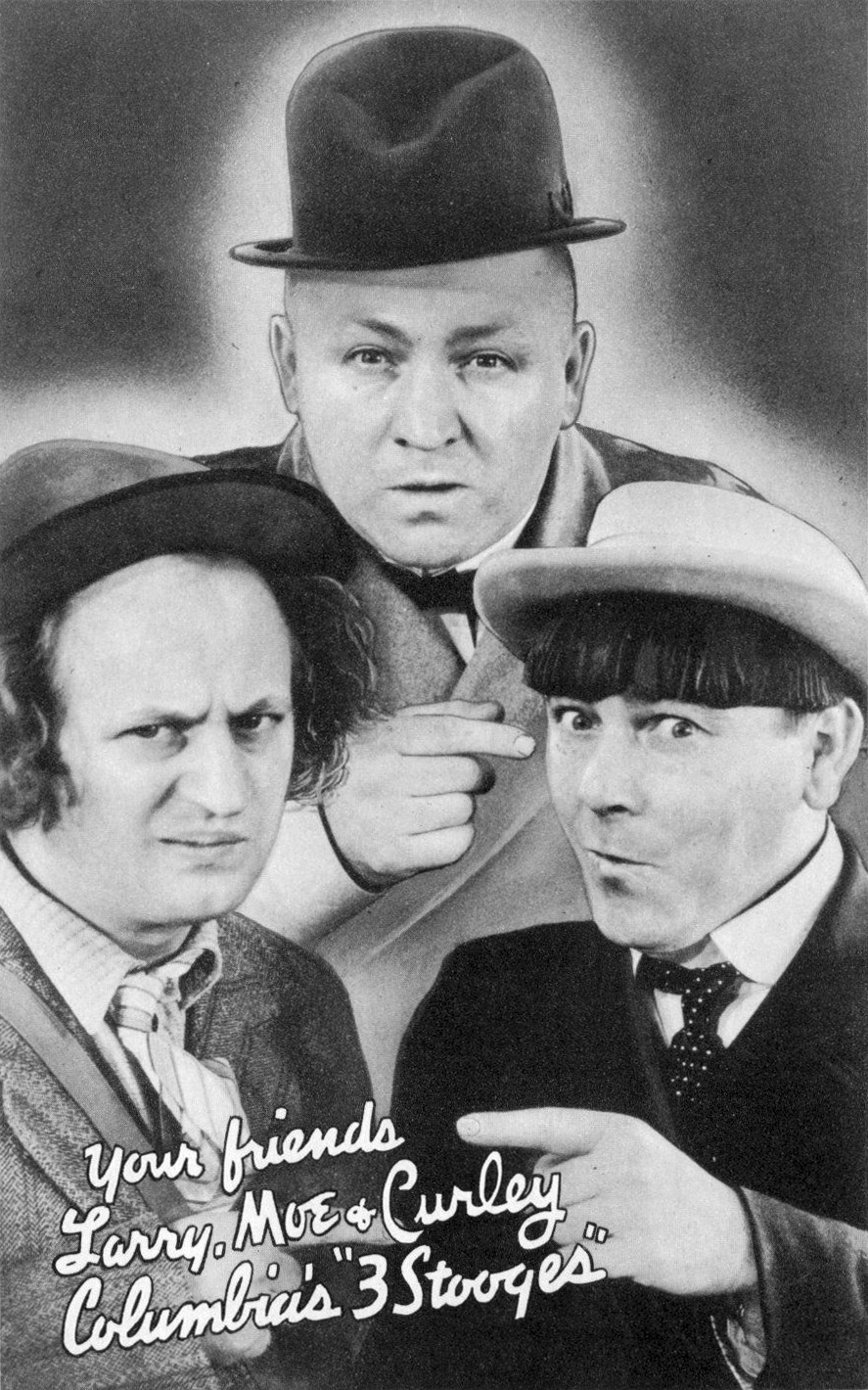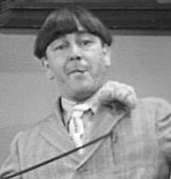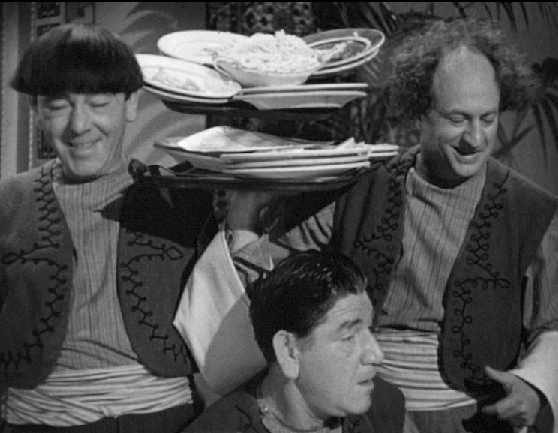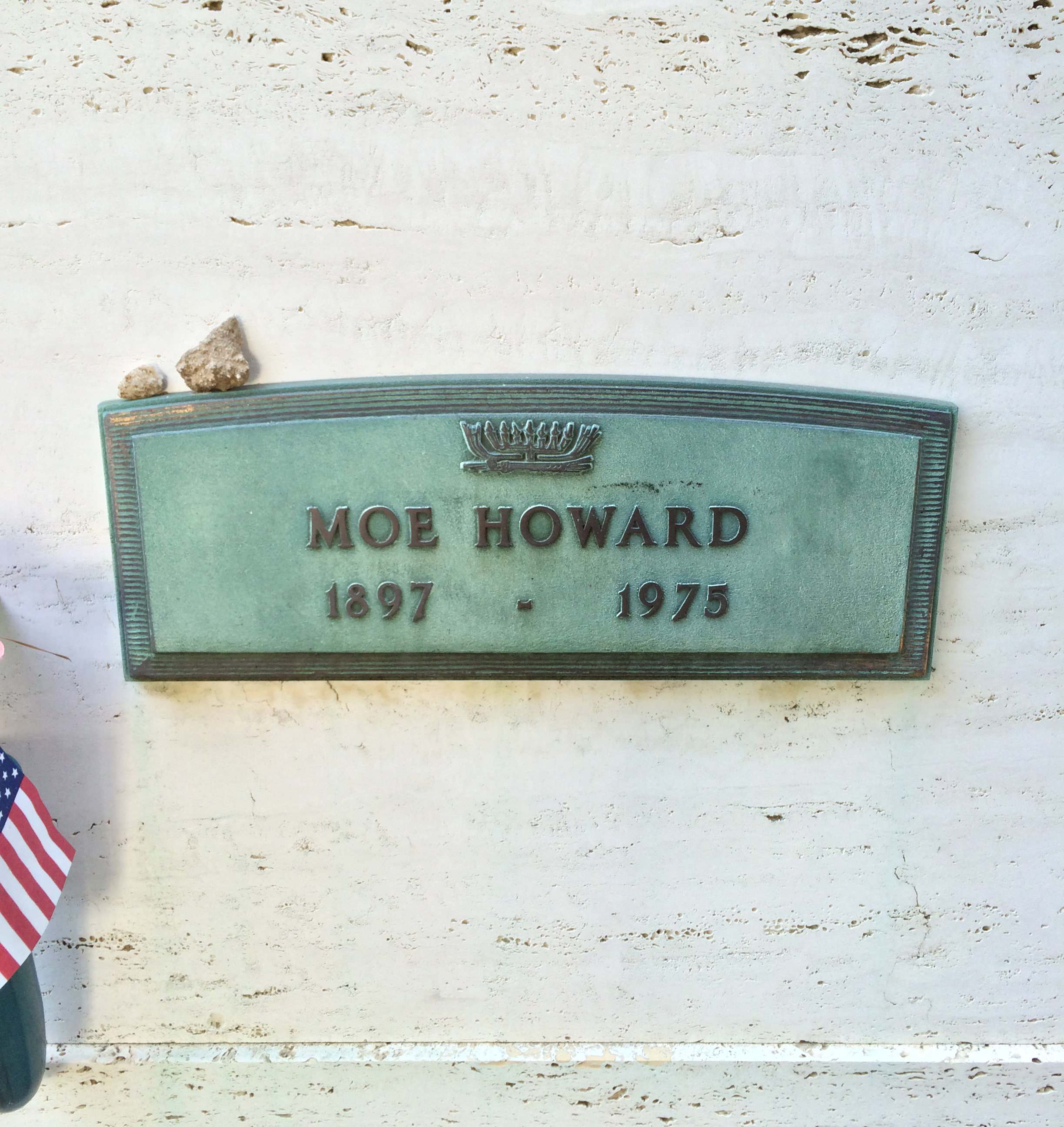1. Early Life and Background
Moe Howard's early life was marked by his family background, a unique hairstyle development, and an early inclination towards the performing arts, which shaped his future career.
1.1. Birth and Family
Moe Howard was born Moses Harry Horwitz on June 19, 1897, in the Bensonhurst neighborhood of Brooklyn, New York. He was the fourth of five sons born to Jennie Gorovitz and Solomon Horwitz, who were Lithuanian Jewish immigrants. Though initially called Moe as a child, he later sometimes referred to himself as Harry. While his parents and older brothers Benjamin ("Jack") and Isidore (Irving) were not involved in show business, Moe and his two other brothers, Samuel (Shemp) and Jerome (Curly), would eventually become famous as members of The Three Stooges.
1.2. Childhood and Education
Howard enjoyed reading, particularly the Horatio Alger books, which his older brother Jack noted helped to spark his imaginative mind and instilled in him ideas of good character and success. This literary interest later proved beneficial in his acting career, allowing him to memorize lines quickly and easily.
His iconic "bowl cut" hairstyle, a significant part of his on-screen persona, came about during his childhood. His mother initially preferred his hair long, letting it grow to shoulder length. However, due to frequent teasing at school, he secretly cut his own hair in their backyard shed, resulting in the irregular, bowl-like shape that became his signature look. He later recalled facing daily conflicts related to school, stating, "I used to fight my way to school, in school, and back home from school."
Howard's growing interest in acting led to a decline in his academic performance and frequent hookey from school. He often stood outside theaters, waiting for an adult to buy him a ticket, as juveniles needed accompaniment. Once inside, he would sit in the balcony, captivated by performances from start to finish, often focusing on his favorite actor. Despite his irregular attendance, he graduated from P.S. 163 in Brooklyn. However, his formal education ended shortly after, as he dropped out of Erasmus Hall High School after only two months. To appease his parents, he briefly took an electric shop course but left after a few months to fully pursue a career in entertainment.
1.3. Early Performing Arts Activities
Moe Howard began his journey in show business by running unpaid errands at the Vitagraph Studios in Midwood, Brooklyn. He was rewarded with small parts in the studio's productions, though most of his early work was lost when a fire destroyed the films in 1910. As early as 1909, Howard met Ernest Lea Nash, who would later become known as Ted Healy and significantly influence his career. In 1912, both Howard and Healy worked a summer job as diving "girls" in Annette Kellermann's aquatic act.
Howard continued to seek show-business experience, even singing in a bar with his older brother Shemp until their father intervened. From 1914, the brothers spent two summers performing with a minstrel show troupe on a Mississippi River showboat. Their act, called "Howard and Howard-A Study in Black," was performed in blackface. Concurrently, they also performed without makeup on a rival vaudeville circuit.
2. Career
Moe Howard's career was largely defined by his pivotal role within 'The Three Stooges', evolving from vaudeville acts to short films and eventually transitioning to television and feature films, marking him as a central figure in comedy history.
2.1. Formation of Ted Healy and His Stooges
In 1922, Moe Howard joined Ted Healy in a vaudeville routine. The following year, during a theater performance, Moe spotted his brother Shemp in the audience and called out to him from the stage. Shemp's heckling responses led to an amusing bickering exchange that prompted Healy to immediately hire Shemp as a permanent part of the act.
In June 1925, Moe temporarily retired from performing after marrying Helen Schonberger, choosing to pursue a career in real estate with his mother. During his absence, Healy's act, with Shemp Howard frequently as a stooge, gained national recognition through the Shubert Brothers' production of A Night in Spain. This show enjoyed a successful run on Broadway and a national tour. While performing in Chicago, Healy recruited vaudeville violinist Larry Fine to join the troupe in March 1928.
After A Night in Spain concluded in late November, Healy signed on for the Shuberts' new revue, A Night in Venice, and persuaded Moe Howard to come out of retirement to rejoin the act in December 1928. In early 1929 rehearsals, Moe Howard, Larry Fine, and Shemp Howard worked together for the first time as a trio. When A Night in Venice closed in March 1930, Healy and the trio toured as "Ted Healy and His Racketeers," a name later changed to "Ted Healy and His Stooges."
2.2. The Three Stooges: Columbia Shorts Era

Ted Healy and His Stooges began to achieve significant recognition, making their first movie, Soup to Nuts (1930), for Fox Films (later 20th Century Fox). The film featured Healy and his four Stooges: Moe (billed as "Harry Howard"), Shemp, Larry, and Fred Sanborn. Following a disagreement with Healy, Moe, Larry, and Shemp decided to perform independently as "Howard, Fine, and Howard," premiering their new act on August 28, 1930, at the Paramount Theatre in Los Angeles. They subsequently toured the RKO vaudeville circuit for nearly two years, eventually calling themselves "Three Lost Souls" and incorporating Jack Walsh as their straight man.
In July 1932, Moe, Larry, and Shemp accepted an offer from Healy to rejoin him for the new Shubert Broadway revue Passing Show of 1932. On August 16, 1932, during rehearsals in New York, Ted Healy left the Shuberts due to a contract dispute. On August 19, 1932, Shemp Howard also gave his notice, having a difficult relationship with Healy, who was known for his drinking and belligerence. Shemp chose to remain with Passing Show, which closed in September after receiving poor reviews from its initial roadshow performances in Detroit and Cincinnati. Shemp then found work at Vitaphone Studios in Brooklyn in May 1933, where he stayed for almost four years.
On August 20, the day after Shemp's departure, Moe suggested that his youngest brother, Jerome (affectionately called "Babe" by Moe and Shemp), join the act. Although Healy initially hesitated, Jerry's eagerness to join led him to shave off his mustache and luxurious auburn hair and run onto the stage during Healy's routine. This convinced Healy to hire Jerry, who adopted the stage name Curly. The new lineup of Moe, Larry, and Curly debuted with Ted Healy on stage at Cleveland's RKO Palace on August 27, 1932. In early 1933, during appearances in Los Angeles, Healy and the Stooges were hired by Metro-Goldwyn-Mayer to inject their "nut" comedy antics into feature films and short subjects.
2.2.1. Moe's Leadership and On-screen Persona

After several appearances in MGM films, Ted Healy began to transition into a solo character comedian. In 1934, his Stooges, by then formally known as The Three Stooges, signed a contract with Columbia Pictures. They remained with Columbia until December 1957, producing 190 comedy shorts.
With Healy's departure, Moe Howard took on the role of the aggressive, take-charge leader of the team. His on-screen persona was characterized by a short temper and a tendency to engage in slapstick violence, often directed at the other two Stooges. Despite this outwardly harsh demeanor towards his companions, Moe was also depicted as fiercely loyal and protective of them in the films, always trying to keep them out of harm's way and coming to their rescue when necessary.
In his autobiography, Moe emphasized that his ill-tempered on-screen character did not reflect his true personality. He also prided himself on being a shrewd businessman, wisely investing the earnings from his film career. However, despite their prolific output, The Stooges received no subsequent royalties (or residuals) from any of their many shorts. They were paid a fixed amount for each film, and Columbia Pictures retained all rights and profits thereafter. According to Larry Fine, Columbia did allow the Stooges to conduct live tours when they were not filming in the 1970s, in exchange for half-salary during those months, which significantly increased their annual income.
2.2.2. Member Changes and Key Films
Columbia released its first Three Stooges short, Woman Haters (1934), a musical romantic farce where their comedic characters were not yet fully developed. It was part of Columbia's "Musical Novelties" series, with rhyming dialogue, and the Stooges supported comedian Marjorie White. Once they became established as short-subject stars, the main titles were updated to give The Stooges top billing, which is the version commonly seen on television and video today.
Their subsequent film, Punch Drunks (1934), holds the distinction of being the only short film entirely written by The Three Stooges. It featured Curly as a reluctant boxer who became uncontrollably violent whenever he heard "Pop Goes the Weasel". Their next short, Men in Black (also 1934), was a parody of the contemporary hospital drama Men in White. This film earned them their first and only Academy Award nomination, known for its classic catchphrases like "Calling Dr. Howard, Dr. Fine, Dr. Howard" and their unison declaration, "For Duty and Humanity!!" as young doctors. They continued to produce short films at a consistent rate of eight per year. Notable works from this period include Three Little Pigskins (also 1934), featuring a young Lucille Ball, Pop Goes the Easel (1935), and Hoi Polloi (also 1935), where two professors attempt to transform the Stooges into gentlemen as part of a bet.

In the 1940s, The Three Stooges incorporated topical themes into their films, producing several anti-Nazi shorts. These included You Nazty Spy! (1940), which Moe Howard considered his favorite Three Stooges film, I'll Never Heil Again (1941), and They Stooge to Conga (1943). Moe's impersonation of Adolf Hitler was a highlight of these shorts; You Nazty Spy! notably premiered nine months before Charlie Chaplin's film satire The Great Dictator.
On May 6, 1946, during the filming of Half-Wits Holiday (1947), Moe's brother Curly suffered a stroke. Curly had experienced a series of strokes even before the filming of Beer Barrel Polecats (1946). Shemp Howard agreed to return to the group, but only until Curly recovered sufficiently to rejoin. Curly did make a cameo appearance in Hold That Lion! (1947), which was an impromptu setup and is the only Three Stooges film to feature all three Howard brothers: Moe, Curly, and Shemp. He was well enough for a second cameo as a chef in Malice in the Palace the following year, but this footage was never used. Curly suffered a second series of strokes, leading to his death at age 48 on January 18, 1952.
After Shemp rejoined the act, Moe, Shemp, and Larry filmed a television pilot for ABC titled Jerks of All Trades (1949). This pilot was seemingly intended to launch a weekly sitcom where the Stooges would attempt a different job or business each week, with comedic results from their inevitable failures. The pilot was filmed in a single day as a kinescope, mimicking a live broadcast, but it was never aired. B.B. Kahane, Columbia Pictures' vice president of business affairs, prevented its broadcast, citing a contract stipulation that restricted The Stooges from appearing in a TV series that might compete with their two-reel comedies. Columbia threatened to cancel their contract and pursue legal action if they tried to sell the series, leading to the project's abandonment. The kinescope film has since entered the public domain and is widely available. However, Columbia did permit The Stooges to make guest appearances on various TV variety shows.
The Three Stooges' short film series maintained its popularity through the 1950s, with Shemp co-starring in 73 comedies. The Stooges also co-starred in Gold Raiders (1951), a Western film alongside George O'Brien. Moe Howard additionally co-produced several Western and musical films during the 1950s.
On November 22, 1955, Shemp Howard died of a heart attack at age 60, necessitating another replacement for the group. Producer Jules White utilized existing footage of Shemp to complete four additional films, with Columbia regular Joe Palma filling in for Shemp (a technique that became known as the Fake Shemp phenomenon). Eventually, Columbia head Harry Cohn hired Joe Besser in 1956. According to Moe's autobiography, Howard had preferred a "two-stooge" act, and the decision to replace Shemp was Cohn's, not his own.
With Joe Besser joining the group, Moe, Larry, and Joe filmed 16 shorts through December 1957. Shortly before Harry Cohn's death in February 1958, the production of short subjects ceased. To stay active, Moe was hired by Harry Romm as an associate producer. Moe refuted claims (and later, scenes in a 2000 made-for-TV biopic) that he was forced to take a job as a gofer at Columbia, asserting these stories were false.
2.3. Transition to Television and Feature Films
Columbia Pictures sold the Three Stooges' extensive library of short films to television under the Screen Gems name. This move quickly introduced The Three Stooges to a new, younger audience, leading to a resurgence in their popularity. Always a shrewd businessman, Moe Howard assembled a new Stooges act, recruiting burlesque and screen comic Joe DeRita. DeRita was dubbed "Curly-Joe" due to his slight resemblance to Moe's late younger brother, Curly Howard, and to distinguish him from Joe Besser. Like Shemp Howard and Joe Besser before him, DeRita had also starred in his own series of comedy shorts.
Many local television children's shows across the United States began syndicating the Stooges' films, including Adventure Time hosted by Paul Shannon on WTAE-TV in Pittsburgh, and Sally Starr's show on WFIL-TV (now WPVI-TV) in Philadelphia. The films became so popular that some young fans attempted to imitate Moe's signature slapstick actions, such as slapping, gouging, and hitting. This prompted The Three Stooges to issue warnings advising viewers against replicating those dangerous actions.
The revitalized trio, featuring Moe, Larry, and Curly-Joe, starred in six full-length feature films: Have Rocket, Will Travel (1959); Snow White and the Three Stooges (1961); The Three Stooges Meet Hercules and The Three Stooges in Orbit (1962); The Three Stooges Go Around the World in a Daze (1963); and The Outlaws Is Coming (1965).
In addition to their feature films, Howard, Larry, and Curly-Joe continued to make live appearances and notable guest appearances. They had a brief cameo as three firemen in It's a Mad, Mad, Mad, Mad World (1963) and a more extended role in 4 for Texas (also 1963), which starred Frank Sinatra and Dean Martin. The group also ventured into children's programming with The New Three Stooges, a cartoon show featuring animated segments interspersed with new live-action footage of the Stooges filmed in color.
During this period, Moe and The Stooges appeared on numerous television variety and talk shows, including The Steve Allen Show, Here's Hollywood, Masquerade Party, The Ed Sullivan Show, Danny Thomas Meets the Comics, The Joey Bishop Show, Off to See the Wizard, and Truth or Consequences. However, by the late 1960s, the members were all at an advanced age, making it increasingly difficult and risky for them to perform their characteristic slapstick comedy without fear of serious injury.
2.4. Later Years and Final Projects
In their later years, Moe Howard and The Three Stooges received residuals from their more recent work and continued to earn a significant portion of profits from sales of Stooges merchandise. When his show-business career slowed down, Moe also engaged in real estate ventures. Despite this, he still took on minor solo roles and walk-on parts in films such as Don't Worry, We'll Think of a Title (1966) and Doctor Death: Seeker of Souls (1973). He also made several appearances on The Mike Douglas Show in the 1970s.
During one memorable appearance on The Mike Douglas Show, Moe, with his hair styled in a contemporary fashion, made a surprise entrance during an interview with the author of a "where-are-they-now" book. When the audience was invited to ask the author questions about famous individuals, Howard himself inquired, "Whatever happened to the Three Stooges?" Upon being recognized by Douglas, he dramatically combed his hair back into his iconic trademark "bowl cut."
The Stooges attempted to make a final film in 1969, titled Kook's Tour. This project was essentially a documentary that showed Howard, Larry, and Curly Joe out of character, traveling across the United States and interacting with fans. Production was halted on January 9, 1970, when Larry Fine suffered a major stroke during filming, which resulted in the paralysis of the left side of his body. Larry Fine subsequently passed away on January 24, 1975, at the age of 72. Despite the interruption, enough footage of Larry had been shot for Kook's Tour to eventually be released in a 52-minute version to home video. After Fine's stroke, Moe Howard asked long-time Three Stooges supporting actor Emil Sitka to replace Larry, but this final lineup never filmed any material.
3. Personal Life
On June 7, 1925, Moe Howard married Helen Schonberger, who was a cousin of the famous illusionist Harry Houdini. Helen was born on December 19, 1899, and passed away on October 31, 1975. The year after their marriage, Schonberger persuaded Howard to retire from show business as she was pregnant. Howard attempted to pursue a living through a series of "normal" jobs, none of which proved very successful, leading him to soon return to working with Ted Healy. Howard and Schonberger had two children: Joan Howard (born April 2, 1927, and died September 21, 2021) and Paul Howard (born July 8, 1935).
4. Filmography
Moe Howard had an extensive career in film and television, primarily known for his work with The Three Stooges. His notable appearances include:
- Soup to Nuts (1930)
- The Hollywood Party (1934)
- Woman Haters (1934)
- Punch Drunks (1934)
- Men in Black (1934)
- Three Little Pigskins (1934)
- Captain Hates the Sea (1934)
- Pop Goes the Easel (1935)
- Hoi Polloi (1935)
- Disorder in the Court (1936)
- You Nazty Spy! (1940)
- I'll Never Heil Again (1941)
- Time Out for Rhythm (1941)
- They Stooge to Conga (1943)
- Swing Parade of 1946 (1946)
- Beer Barrel Polecats (1946)
- Half-Wits Holiday (1947)
- Hold That Lion! (1947)
- Jerks of All Trades (TV pilot, 1949)
- Malice in the Palace (1949)
- Gold Raiders (1951)
- Have Rocket, Will Travel (1959)
- Snow White and the Three Stooges (1961)
- The Three Stooges Meet Hercules (1962)
- The Three Stooges in Orbit (1962)
- The Three Stooges Go Around the World in a Daze (1963)
- It's a Mad, Mad, Mad, Mad World (1963)
- 4 for Texas (1963)
- The New Three Stooges (animated TV series, 1965-1966)
- The Outlaws Is Coming (1965)
- Don't Worry, We'll Think of a Title (1966)
- Kook's Tour (1970)
- Doctor Death: Seeker of Souls (1973)
5. Death and Legacy
Moe Howard's passing marked the end of an era for The Three Stooges, but his lasting impact on comedy and entertainment continues to be recognized.
5.1. Death

Moe Howard died of lung cancer at the age of 77 on May 4, 1975, at Cedars-Sinai Medical Center in Los Angeles, where he had been admitted a week earlier in April. His death occurred just over three months after Larry Fine's passing and shortly before his 78th birthday. Howard had been a heavy smoker for much of his adult life. He was interred in an outdoor crypt at Culver City's Hillside Memorial Park Cemetery. His wife, Helen Schonberger, died of a heart attack on October 31, 1975, at age 75, and was interred in the crypt next to him. At the time of his death, Howard was working on his autobiography, which was posthumously released in 1977 under the title Moe Howard and the Three Stooges.
5.2. Legacy and Portrayals
Moe Howard, along with The Three Stooges, received a posthumous star on the Hollywood Walk of Fame on August 30, 1983. Their star is located at 1560 Vine Street.
Howard's life and work have been depicted in various media. He was portrayed by Paul Ben-Victor in The Three Stooges, a 2000 made-for-television biopic that explored the trio's years in show business and their lives off-screen. In the 2012 Farrelly brothers' film, The Three Stooges, Chris Diamantopoulos played the role of Moe, while Skyler Gisondo portrayed Young Moe.